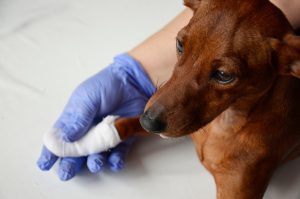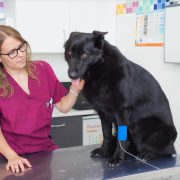Determination of a safe sedative combination of dexmedetomidine, ketamine and butorphanol for minor procedures in dogs by use of a stepwise optimization method
Determination of a safe sedative combination of dexmedetomidine, ketamine and butorphanol for minor procedures in dogs by use of a stepwise optimization method

Open access
In our edition of: Dec 2023
In our categories of: small animals
our summary:
Imboden, T.J. et al. (2023) Determination of a safe sedative combination of dexmedetomidine, ketamine and butorphanol for minor procedures in dogs by use of a stepwise optimization method. Acta Veterinaria Scandinavica, 65, no. 41.
The aim of this randomised three-phase controlled trial was to determine the optimal dosages of dexmedetomidine and ketamine in combination with butorphanol 0.3 mg/kg in terms of the quality of sedation, side effects, and the need for additional anaesthetics.
One hundred and eighty healthy client-owned dogs were included in the study. The reasons that sedation was required included radiographs, computer tomographic examinations, skin biopsies, wound treatments, external fixator removals, and other diagnostic or therapeutic procedures. Each phase of the study used a negative scoring system (NS) to evaluate the quality of sedation in each patient. The NS included scores for the major parameters breathing, signs of onset of sedation, need for propofol, and behaviour during recovery. Minor parameters scored included behavioural reactions during injection of the test drug, catheter placement, positioning on the table and atipamezole injection, as well as the time spans to sternal and standing positions.
In phase 1 of the trial eight different combinations of dexmedetomidine, ketamine and butorphanol were tested, in these the dosages of dexmedetomidine and ketamine varied but the butorphanol was kept constant at 0.3 mg/kg. Each combination was tested on six dogs with the person performing the procedure blinded as to combination. The combinations were then ranked according to the NS score into ‘promising’ or ‘unsatisfactory’.
For phase 2 a new combination was calculated, based on the results of phase 1, and tested on six dogs replacing the worst of the eight initial combinations. This procedure was repeated until the NS could not be improved any further. In phase 3 the best combination was tested on 100 healthy dogs undergoing minor procedures
The optimal combination from phases 1 and 2 was dexmedetomidine 0.005 mg/kg, ketamine 1 mg/kg, and butorphanol 0.3 mg/kg. In phase 3 the results for this combination showed that the NS increased slightly with increasing length of procedure. Length of sedation had a positive correlation with recovery duration, there was no correlation between NS and age and a slight negative correlation between NS and weight with the NS slightly decreased with increasing body weight. In all dogs the quality of sedation was satisfactory and there were no severe side effects.
Limitations of the study include the lack of blinding in phase 2 and 3 of the study, the wide variety of included procedures, and the lack of information on how the dosage regimes in phase 1 were decided and how the dogs were allocated to each test group.
Using a stepwise method this study identified an optimal combination of drugs which provided a reliable and safe level of sedation for various diagnostic and therapeutic procedures in healthy dogs. Further studies with a larger sample size are encouraged.
The following may also be of interest:
Adami, C. et al. (2016) Combinations of dexmedetomidine and alfaxalone with butorphanol in cats: application of an innovative stepwise optimisation method to identify optimal clinical doses for intramuscular anaesthesia. Journal of Feline Medicine and Surgery, 18 (10), pp. 846-853. https://doi.org/10.1177/1098612X15596563
Claiming CPD for reading inFOCUS articles
Reading and reflecting on articles can count towards your CPD, and we have a template to help you with the process.
Image copyright attribute: betterphoto






Leave a Reply
Want to join the discussion?Feel free to contribute!